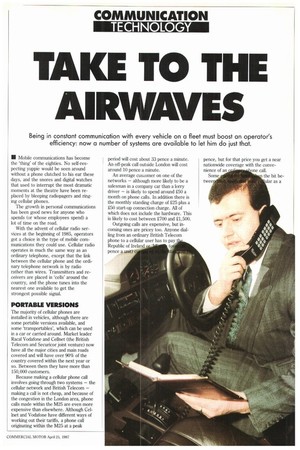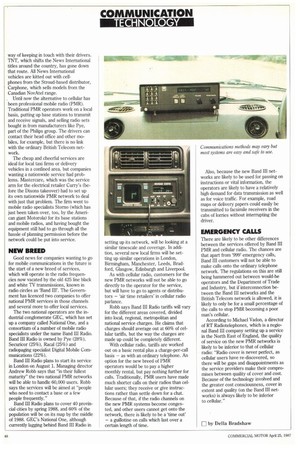TAKE TO THE AIRWAY
Page 49

Page 50

If you've noticed an error in this article please click here to report it so we can fix it.
Being in constant communication with every vehicle on a fleet must boost an operator's efficiency: now a number of systems are available to let him do just that.
IN Mobile communications has become the 'thing' of the eighties. No self-respecting yuppie would be seen around without a phone clutched to his ear these days, and the snores and digital watches that used to interrupt the most dramatic moments at the theatre have been replaced by bleeping radiopagers and ringing cellular phones.
The growth in personal communications has been good news for anyone who spends (or whose employees spend) a lot of time on the road.
With the advent of cellular radio services at the beginning of 1985, operators got a choice in the type of mobile communications they could use. Cellular radio operates in much the same way as an ordinary telephone, except that the link between the cellular phone and the ordinary telephone network is by radio rather than wires. Transmitters and receivers are placed in 'cells' around the country, and the phone tunes into the nearest one available to get the strongest possible signal.
PORTABLE VERSIONS
The majority of cellular phones are installed in vehicles, although there are some portable versions available, and some 'transportables', which can be used in a car or carried around. Market leader Racal Vodafone and Cellnet (the British Telecom and Securicor joint venture) now have all the major cities and main roads covered and will have over 90% of the country covered within the next year or so. Between them they have more than 150,000 customers.
Because making a cellular phone call involves going through two systems — the cellular network and British Telecom — making a call is not cheap, and because of the congestion in the London area, phone calls made within the M25 are even more expensive than elsewhere. Although CelInet and Vodafone have different ways of working out their tariffs, a phone call originating within the M25 at a peak period will cost about 33 pence a minute. An off-peak call outside London will cost around 10 pence a minute,
An average cusi.omer on one of the networks — although more likely to be a salesman in a company car than a lorry driver — is likely to spend around 250 a month on phone calls. In addition there is the monthly standing charge of £25 plus a £50 start-up connection charge. All of which does not include the hardware. This is likely to cost between £700 and £1,500.
Outgoing calls are expensive, but incoming ones are pricey too. Anyone dialling from an ordinary British Telecom phone to a cellular user has to pay Republic of Irelan pence pence, but for that price you get a near nationwide coverage with the conve nience of an one call.
Some the bit be twee ular as a way of keeping in touch with their drivers. TNT, which shifts the News International titles around the country, has gone down that route_ All News International vehicles are kitted out with cell phones from the Stroud-based distributor, Carphone, which sells models from the Canadian NovAtel range.
Until now the alternative to cellular has been professional mobile radio (PMR). Traditional PMR operators work on a local basis, putting up base stations to transmit and receive signals, and selling radio sets bought in from manufacturers like Pye, part of the Philips group. The drivers can contact their head office and other mobiles, for example, but there is no link with the ordinary British Telecom network.
The cheap and cheerful services are ideal for local taxi firms or delivery vehicles in a confined area, but companies wanting a nationwide service had problems. Mastercare, which was the service arm for the electrical retailer Curry's (before the Dixons takeover) had to set up its own nationwide PMR network to deal with just that problem. The firm went to mobile radio specialists Storno (which has just been taken over, too, by the American giant Motorola) for its base stations and mobile radios, and having bought the equipment still had to go through all the hassle of planning permission before the network could be put into service.
NEW BREED
Good news for companies wanting to go for mobile communications in the future is the start of a new breed of services, which will operate in the radio frequencies now vacated by the old 425 line black and white TV transmissions, known in radio circles as 'Band III'. The Government has licenced two companies to offer national PMR services in those channels and several more to offer local services.
The two national operators are the industrial conglomerate GEC, which has set up a company called National One, and a consortium of a number of mobile radio specialists under the name Band III Radio. Band III Radio is owned by Pye (28%), Securicor (25%), Racal (25%) and radiopaging specialist Digital Mobile Communications (22%).
Band III Radio plans to start its service in London on August 1. Managing director Andrew Robb says that "in their fullest maturity" the two national PMR networks will be able to handle 60,000 users. Robb says the services will be aimed at "people who need to contact a base or a few people frequently."
Band III Radio plans to cover 40 provincial cities by spring 1988, and 60% of the population will be on its map by the middle of 1988. GEC's National One, although currently lagging behind Band III Radio in setting up its network, will be looking at a similar timescale and coverage. In addition, several new local firms will be setting up similar operations in London, Birmingham, Manchester, Leeds, Bradford, Glasgow, Edinburgh and Liverpool.
As with cellular radio, customers for the new PMR networks will not be able to go directly to the operator for the service, but will have to go to agents or distributors — 'air time retailers' in cellular radio parlance.
Robb says Band III Radio tariffs will vary for the different areas covered, divided into local, regional, metropolitan and national service charges. He claims that charges should average out at 60% of cellular tariffs, but the way the charges are made up could be completely different.
With cellular radio, tariffs are worked out on a basic rental plus a charge-per-call basis — as with an ordinary telephone. An option for the new breed of PMR operators would be to pay a higher monthly rental, but pay nothing further for calls. Traditionally, PMR users have made much shorter calls on their radios than cellular users; they receive or give instructions rather than settle down for a chat. Because of that, if the radio channels on the new PMR systems become congested, and other users cannot get onto the network, there is likely to be a 'time out' — a guillotine on calls which last over a certain length of time. Also, because the new Band III networks are likely to be used for passing on instructions or vital information, the operators are likely to have a relatively high demand for data transmission as well as for voice traffic. For example, road maps or delivery papers could easily be transmitted to facsimile receivers in the cabs of lorries without interrupting the driver.
EMERGENCY CALLS
There are likely to be other differences between the services offered by Band III PMR and cellular radio. The chances are that apart from '999' emergency calls, Band III customers will not be able to make calls onto the ordinary telephone network. The regulations on this are still being hammered out between would-be operators and the Department of Trade and Industry, but if interconnection between the Band III networks and the British Telecom network is allowed, it is likely to only be for a small percentage of the calls to stop PMR becoming a poor man's cellular.
According to Michael Vadon, a director of RT Radiotelephones, which is a regional Band III company setting up a service in the North East of England, the quality of service on the new PMR networks is likely to be inferior to that of cellular radio: "Radio cover is never perfect, as cellular users have re-discovered, so there will be gaps and disappointments as the service providers make their compromises between quality of cover and cost. Because of the technology involved and the greater cost consciousness, cover in extent and quality (on the Band III networks) is always likely to be inferior to cellular."
0 by Della Bradshaw
























































































































